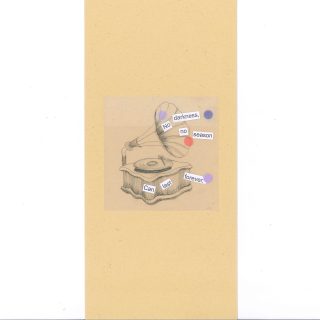We must immerse ourselves in the atmospheric experience of architecture, where it seems that there is a door hidden that can open us a wider horizon of dealing with the past. Atmospheric architecture (Böhme)[i] immerses us in the sensory aspect of space and, if we invert this approach, we can immerse ourselves in the spatial sense of the past. Consequently, in the context we are talking about, we can feel space through the noise it carries. In art history books, the epithet of creator of worlds is given to the architect and the musician – the act of creation is closely associated with them both formally and emotionally. They create areas where our experiences manifest. Our memories are made tangible through the poetic imagery of space and the sense of haunting that emerges through sound. Therefore, in a more familiar sense, we can say that the architect and the musician are direct and indirect participants in the worldliness of the world (Heidegger). In other words, it seems that the song, sound or noise that we have heard we can remember exactly where we heard it, because the space is not only visual, but also belongs to that inner experience that we can only grasp through hearing and touch.
Inner experience is crucial in the most profound ravages of the past, because there the material of an experience is fully understood – all the disturbances, pleasures, tensions and emotional impulses of a certain milieu are highlighted or manifested by a disturbing sound that relives a time, a moment and our memory of it. Noises can remind us of social status (exteriority), such as the news we hear, political gatherings, debates in cafes and street protests, while it also reminds us of emotional status (interiority), the feeling of satisfaction when we have heard a song, the fear of a rustling on the dark side of the city to the screams of violence that mark the nocturnal aspect of the inhuman machine. It seems that the noise that this inhuman machine emits is a nemesis or a cob that leaves its roots, where “we” the human species, as an eternal return, are again confronted with the fundamental question posed by Primo Levi ‘Are we human?’.[ii] Therefore, the sound space and the sound milieu are important moments if we want to search for traces of the past and collective memory. In this line of discourse, we can extend to empirical or everyday examples, where one such is “Boro e Ramizi” or “The Palace of Youth” in Prishtina. It has not only served for the “igranks” (“parties” in Albanian, as they were called in vernacular usage during the Yugoslavian period) of its citizens or any concert scene of a rock band that our parents could have heard. But, at the same time, during apartheid and the war, the corridors of this brutalist building served as a factory where its citizens were raped. The rape that took place inside this brutalist building are documented, the most macabre acts of inhuman machinery took place there. Therefore, sound spaces and sound milieus are not only a reminder of an entertaining experience full of chaste pleasure, but also a hiding place where the nocturnal aspect of our being is hidden, where inhuman nemesis dwell in their demonic evil. Where the real is broken, as Lacan says.[iii]
The role and importance of spaces is not as previously perceived as empty and bastard materiality. They are more, because they create areas of pleasure (Freud), but also areas of horror. We immerse ourselves in an acoustic intimacy on both levels with space and sound. So, the sound, the note, the music, the song and the noise somehow create an acoustic intimacy where in those memory drawers not only the individual conscious and unconscious is expressed, but, using Jung’s trope, the conscious and the collective unconscious are expressed there. This acoustic intimacy is important to trace for the past or the collective memory, because it now, in the form of a ghost, manifests itself to us in the present. Mutating the “sound object” (Schaeffer)[iv] in the form of music, loud speakers in protests, screams of violence, raised voices in debates, chanting as resistance in protests, TV-God with his news; all these have been orientations that have increased our sensitivity to where we are living. Linguist Walter Ong has a tantalizing thesis about sound when he asserts that “the central action of sound is to affect man’s sense of the cosmos.“[v] So the auditory structure here implies the articulation and experience of space. If we radicalize this thesis, we cannot understand the political/social and artistic context of Kosovo – we do not know its auditory structure and that keeps the secret that can reveal its space to us. Perhaps the unfolding of space makes us aware of the nocturnal side of war. Lately, I have experienced an epiphany as a reflexive instance, that the unfolding of space highlights our pains, anxieties, insecurities and that they are all connected with a high-frequency sound that almost deafens us, and this is the moment where our memories of phonotopes or sound spaces is stratified. As a parenthesis for discussion, both of the phonotopes that I have reviewed in the previous texts, which are the Oda and the Cafeteria, express two forms of atmospheric experience, which is the monumental aural space and the intimate aural space. We cannot separate the monumental and the intimate here; belonging to one phonotope or the other, but both of which are interwoven in the manifesting structure of these phonotopes. What is monumental and intimate is closely related to the experience, touch and gesture of the aural space.
Monumental and Intimate
We must first define the use of the monumental to give context to this entire discourse. Monumental here is used in the Heideggerian sense that it does not serve as a marker of some traces of the past, nor a memorization of someone or something in time, but it is for others, in the sense that it serves as a marker of an event or occurrence. Therefore, as the philosopher Gianni Vattimo sees it, the monumental here is not to overcome time as immortality, but, on the contrary, it is mortal because it has to endure time.[vi] In this context, “Oda” is monumental, because there are verses, sounds that can remind us of our past. With its monumentality in the form of the atmosphere, it tries to beat time by remaining stoic and at the same time serves as an orienting compass of a morality that has its foundation in some customary values and that, as I mentioned earlier, has the function of a shield. Another segment that we explain through the lenses of cultural anthropology is that the monumentality of the “Oda” cannot be maintained by what Levi-Strauss calls “mytho-poiesis”[vii] or the creation of myths. In these myths, a kind of sacrifice is exalted for some sublime values related to freedom and, as an apex, it has martyrdom for that freedom. During the occupation, these rhapsodic expressions had the function of a mobilization against oppression, but in the current context, in some cases, the regressive character and the national-romantic trap that serves as a catalyst to exclude the other can be observed. These mythologies and mystifications in the created context serve as theories of compensation and are regressive, because their monomania tends to deny plural values and does not represent something we can call “patriotism” – here I mean in its most progressive variant, that “constitutional patriotism” that we find in Habermas[viii] and Muller.[ix] Myths in the Balkans have been a function of chauvinistic propaganda, which have fed hatred in the social body. They were symbolic and linguistic forms that had the function of inciting hatred. We have the case of the myth of Tsar Lazar; its repercussions are mass extermination of genocidal proportions. Once again the old continent, after the consequences arising from the myths that it had experienced through the destructive machinery of Auschwitz and Gulag, must face again after 50 years the same fate, because the myth had completed the by-product of the craftsmanship that does the best and that is the injection of hatred towards the other, now the woe covered in blood passes through Srebrenica, Vukovar and Reçak.
I know it’s hard to go back on what I said; I feel it myself, but we must continue the discourse by adding that the monumental as atmosphere found in ‘çiftelia’ songs does not tend to be immortal, but to resist time by trying to conserve some traditional feelings and manners. Here, tradition should not be seen as closure, but something that can be improved and adapted to new contexts, as sociologist Gani Bobi points out in his book “Cultural Paradox.”[x] In addition to the monumental aspect, the “Oda” also has an intimate aspect, which is the inner feeling we get from the sounds, whether they are musical, whether they are sounds that are part of the Oda itself. It is said throughout the history of Kosovo, but I also heard it as an anecdote from a friend, that every “Oda” or “House” has its own sound and vibration. The vibration or sound of the “Oda” or “House” does not disturb their owners, only those who are guests, because they are not yet adapted to the sound or vibrations of that space. This is the acoustic intimacy that architectural phenomenologists talk about; it is the sensory atmosphere we experience that defines the aural space. In the context of “Oda”, monumentality and intimacy situate the human and historical experience of this sonosphere.
Cafeterias, as the basic premise of the atmosphere in the spatial plane, are more involved in the intimate aspect. At each table, noises, whispers, screams, arguments and music are experienced differently, each table creates a special veil of experience. The only sound intervention that makes this heterogeneity homogeneous is a song that a majority of the participants in the “cafe” might like. In the spatial structure of the cafeteria there are some ornaments that give it a “schmeck-sphere” and that at the same time its markers are the music studios where the music was released with cassettes, records and in the most advanced variants also the CD and the speakers that have to conveyed a certain mood. In the context we’re talking about, Kurrizi is the most comprehensive example, where you can find a variety of styles, generations, worldviews that each of them gravitated to his favorite cafe; from blues/jazz to metal, from darkwave/punk to alternative music. Everyone was satisfied for a while with its messianism – with a utopia belonging to Kafka’s third world, belonging neither to earthlings nor to gods. Sometimes, that Kurrizi space where Coca-Cola was drunk and hamburgers were eaten looks like a scene from a movie by Trier or Herzog, where gray colors cannot stop the internal vibration of a cold “Peja” beer and a favorite song. But this aural space that has been the engine for a more subversive thought outside the dominant discourse scene is found in the situation of the transition from the communist utopia to the national-romantic utopia of the 90s, where there is no place for the third party for the liber (the free), because he has been silenced by utopia, this is an inhabitant of Kafka’s third land. This situation is described quite well by Migjen Kelmendi in his emblematic essay that is a tour de force in the 90s, entitled ” Retro: Të shituar utopie”.[xi] In this essay, the monumental and the intimate merge into one, when he, with a melancholic intonation, disenchanted by any messianism, affirms that: “‘WE’ fled to remember that it is difficult to be a ‘hero’ of a city without a river.” Because you can only be a hero for a day.” This is the epigraph to the alternative culture of the 90s and the understanding of the aural space of that time. Here the monumentality is of the homo-tantum, the man with a small V and no qualities of Musil, there is no mythical figure for permanent liberation, but a hero of the plastic life of Bowie and Warhol and that for Migjeni is a hero only for a day. As in Bowie’s song “Heroes” and those 15 minutes of fame that Warhol’s “Dandy” had given to all of us. Urban myth, although it uses tropes of phantasmagoric myths, tends to contextualize them within the everyday and dynamic of urban life. For example, the word ‘shituar’ (eng: spellbound), which entails the punishment of the fairies to being spellbound, if we make a jazz-like intervention and use the hermeneutic tools, ‘shituar’ can also be translated as sold out by utopia and messianism itself. We also find this melancholy, disenchantment with utopia and messianism in the books of theorists who were current at the time, and some of them tried to open new paths, some underlining the despair of the lost prophecy, some calling for a vitality in melancholy as fight with ghosts. And we had a bigger problem: we were occupied, isolated and not free, and, consequently, you cannot be a hero in a time without time.
Finally, the monumental and the intimate are the markers of the sensory experience of phonotopes. At the same time, they shape the narrative identity of the 90s and the consequences, extensions, mutations and metamorphoses that will be produced after the liberation. Perhaps the monumental and intimate of 90s can best be described by the insert of Migjen Kelmendi’s book published in 1997, entitled “Na dutz Na ho Utz – P’ej shpije” which goes: “I am often asked whether ‘Gjurmët’ will ever get together. One of my demagogic answers says: We must first make Kosovo, and then we will easily get ‘Gjurmët’ together!”[xii] All the multi-layers of the narrative identity of the 90s is encapsulated in the effort for freedom and in making Kosovo.
Labinot Kelmendi is a philosopher coming from Prishtina. He earned his MA in Philosophy from University of Prishtina, Faculty of Philosophy, Department of Philosophy, and is currently pursuing his PhD in Philosophy at the Faculty of Philosophy of the University of Zagreb. Presently, he serves as an assistant in the Faculty of Philosophy (Department of Philosophy) and the Faculty of Arts. Additionally, he holds a position on the presidency of the Kosovo Philosophical Association. From 2015 to 2021, he co-authored Kosovo’s first philosophical telecast, “Filozofema,” aired on Radio Television of Kosovo (RTK). He chairs the International Inter- and Trans-Disciplinary Symposium for Philosophy, Art, and Technology, known as “Filozofema.” Beyond academia, he actively engages in the cultural realm, initially as a member of various bands and alternative music projects, including the popular “Madgod” and “Elektorati Intelektual.” Subsequently, he contributed articles to the “Cineks” platform, offering critiques on local films and serving as curator and art critique for the drawing biennial and other exhibitions.
[i]Gernot Böhme (2017), Atmospheric Architecture: Aeshtetics of Felt Spaces, Bloomsbury Academics
[ii]Primo Levi (2016), A jemi, vallë, njeri?, Pegi
[iii]Jacque Lacan (2007) Écrits, W. W. Norton
[iv]Pierre Schaeffer (2012) In the Search for Concrete Music, University of California Press
[v]Walter J. Ong (2012) Orality and Literacy, Routledge
[vi]Gianni Vattimo (1991) The End of Modernity: Nihilism and Hermeneutics in Postmodern Culture, John Hopkins University Press
[vii]Claude Levi- Strauss (1995) Myth and Meaning: Cracking the Code of Culture, Schocken
[viii]Jurgen Habermas (2001) The Postnational Constellation: Political Essays, MIT
[ix]Jan-Werner Muller (2021) Patriotizmi kushtetues, Pema
[x]Gani Bobi (1986) Paradoksi Kulturor, Rilindja
[xi]Migjen Kelmendi (1993) Retro: Të shituar utopie, Revista “Thema”, Shoqata e Filozofëve dhe Sociologëve të Kosovës
[xii]Migjen Kelmendi (1997) Na dutz Na ho Utz – P’ej shpije, MM




